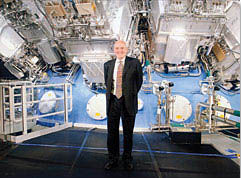SPIE notes impact of laser research facility as report comes out on important step toward generation of fusion energy
BELLINGHAM, Washington, USA -- Researchers at the U.S. National Ignition Facility (NIF) at Lawrence Livermore (California) National Lab (LLNL) have reported an important breakthrough in the work toward producing energy through fusion, imitating the process occurring inside the Sun. Leaders of SPIE, the international society for optics and photonics, commended the work, aimed at developing technology to be applied in converting abundant hydrogen -- from seawater -- into helium, to generate energy.
The work was reported in a paper by Omar Hurricane and other authors from NIF published 12 February in the journal Nature.
 |
| Eugene Arthurs at the NIF dedication in 2009. |
"The NIF team members are working their way toward solving a noble challenge of benefit to Earth's inhabitants and its ecosystems, through replicating the Sun's natural fusion process to generate new sources of clean, sustainable energy," said SPIE CEO Eugene Arthurs. "This latest breakthrough is an important step. Even as they work toward that goal, their work is already benefitting industry through the development of new materials and manufacturing processes and stimulating job creation, and providing other research groups with a unique state-of-the-art facility for other laser-based research."
NIF's 192 laser beams create temperatures and pressures similar to those that exist only in the cores of stars and giant planets, and inside nuclear weapons. The goal is to focus the intense energy from the laser beams on a BB-sized target filled with hydrogen fuel, fusing the hydrogen atoms' nuclei and releasing energy. NIF's first major goal toward fusion is to pass the break-even point -- to generate more energy from the reaction than was required to initiate it.
 |
| Mike Dunne |
"This latest result is very important, since it marks the first time that any approach to fusion has generated a greater amount of energy than was initially absorbed by the fuel. In fact, in the most recent experiments of the past few weeks, the fusion energy output was more than double the input," said NIF Program Director for Fusion Energy Systems Mike Dunne. "Of course, we still have some work to do to get to ignition."
Ignition -- defined to be when a megajoule of fusion energy is released -- is a threshold process and needs exquisite control of the initial conditions, he explained. "Fortunately, the astounding level of agreement between simulation and experiment in these latest results provides a robust platform for future studies for the very first time."
The facility is providing additional benefits beyond its fusion research.
"As SPIE have recognized and are helping to drive forwards, there are many benefits that spin out from a high-power laser project such as the NIF," he said. "It has helped enable the development of a new generation of laser technology for advanced material processing and exploration of applications to homeland security and clinical diagnostics, as well as studies of fundamental science and the pursuit of fusion energy. The work on the NIF was a partnership between 3,000 industrial vendors, and now attracts scientific collaborations with dozens of universities from across the world. Such strong and mutually beneficial links between academia, industry, and government are at the heart of the National Photonics Initiative, which I hope our whole community will rally behind to demonstrate the impact of our field on society."
The National Photonics Initiative is an industry-driven campaign to guide photonics research and funding. SPIE is a Founding Sponsor.
In the work reported this week by NIF, the hydrogen isotopes fused, generating new particles and heating the fuel further and generating still more reactions, particles and heat. The experimental results have matched computer simulations much better than previous experiments, providing an important benchmark for the models used to predict the behavior of matter under conditions similar to those generated during a nuclear explosion, a primary goal for the NIF. The key to the improved results was a modification of the laser pulse used to compress the fuel, a press release from LLNL explained.
SPIE is the international society for optics and photonics, a not-for-profit organization founded in 1955 to advance light-based technologies. The Society serves more than 256,000 constituents from approximately 155 countries, offering conferences, continuing education, books, journals, and a digital library in support of interdisciplinary information exchange, professional networking, and patent precedent. SPIE provided $3.2 million in support of education and outreach programs in 2013.
###
Contact:
Amy Nelson
Public Relations Manager
amy@spie.org
+1 360 685 5478
@SPIEtweets